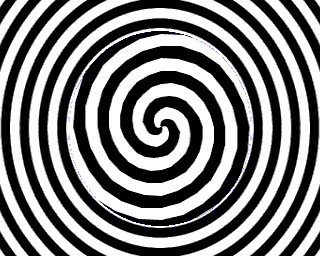
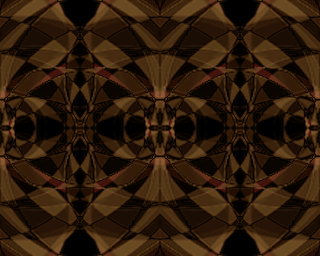
The Moving Image
Rod Munday
WARNING
Approximately one in four thousand people suffers from Photosensitive Epilepsy (PSE). PSE is sensitivity to flickering or intermittent light stimulation and visual patterns. If you start to feel ill when looking at this page, do not persist as it is possible that you suffer from PSE and prolonged exposure to some of these images could result in a seizure.
Our focus here is on the perception of motion pictures. As David Cook remarks, motion pictures occupy a central position in our lives and yet few people understand how they work, so much so that "If we made an analogy with verbal language we should be forced to consider ourselves barely literate" (Cook 1981, XV).
It is thought that humans perceive movement due to processes that occur both in the eye and in the brain. Light falling on a set of receptors in the eye at one instance and on another nearby set in the next instance successively stimulates adjacent retinal points, which is how we see movement with the eye. However, cortical cells in the brain respond to these changes of light which is how we know something moves (Haber & Hershenson 1980, 208).
All too often, we discuss movement perception as though all we had to consider was the perception of a moving object by a static subject. (As shown in session 3), this is hardly ever the case. Our vision is very well developed, because as perceivers, we have a tendency to move around a lot. Yet we are still able to perceive other moving things in a seemingly static world (ibid.). These twin faculties of retinal stabilisation and motion detection gives us an extraordinary ability to recognise moving objects, even if we are given next to no information about them. For example (as noted in session 7) the Swedish psychologist Gunnar Johansson showed an arrangement of lights placed on each of the major joints of a human body was immediately recognised as a person as long as the person moved (Miller 1990, 189). Incidentally Johansson's findings were later exploited to form the basis of motion capture in film like King Kong (Peter Jackson, 2005) and The Polar Express (Robert Zemeckis, 2004) (for more information about motion capture, see Sturman, 1999).
The limitations of seeing movement
Despite our amazing ability to recognise moving shapes, our perception of movement falls within certain thresholds. Movement which is either too fast of too slow is not detectable. At one extreme we are unable to see a bullet fired from a gun, at the other we are unable to detect the motion of an hour hand going round a clock face. It is also possible to fool the brain into thinking there is movement where actually none exists. Such phantom movement is created by lookin at something constantly in motion, like a waterfall, and then looking at something which is not moving. If you do this, you will find that the stationary scene appears to be moving in the opposite direction to the waterfall, i.e., up. This illusion is called "the waterfall illusion." One example was shown in session 6; another variation of it is illustrated in Fig 1.
 |
 |
Fig 1 - Instructions: stare at the spiral for about 20 seconds, then stare at the pattern.
In a study that looked at similar spiral discs Spigel (1962) it was reported that all observers saw the spiral move in the opposite direction. The after effect lasted ten seconds on average.
Moving PicturesThe way that we perceive movement in film is different to the way we perceive moving objects in real life, since film images do not really move at all. In fact an imaging technology has yet to be invented that can represent 'true motion'. The motion represented in television, films, computer games, multimedia presentations etc. is known as apparent motion. Apparent motion is created by displaying a series of consecutively photographed still images in quick succession.
Apparent motion in film projection
Let's look in more detail at how the illusion of apparent motion is created in cinema projection. When you look at a strip of film you can see that it is made up of a series of still pictures (called frames) which are arranged vertically down the length of the film. However, just running this film through a projector would not by itself create the illusion of movement; in fact the result would be a meaningless blur. So the mechanism of the projector is constructed in such a way that each frame is paused momentarily in front of the projector's light source. The gap between frames is also marked by an equally short period of black. This is created by a device called a shutter. In Fig. 2, this shutter is represented as a twin blade rotating disc that resembles the blades of a fan.
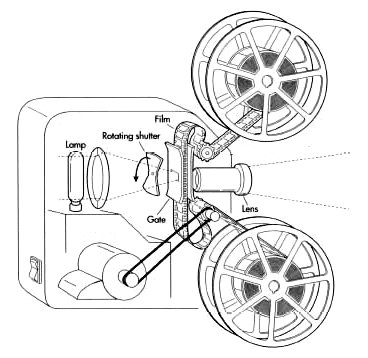 .
.
Fig 2 - A film projector
The shutter blades pass over the beam emitted by the lamp, blanking the light out at regular repeated intervals and effectively turning the projector light into a kind of strobe. The strobing of the projector is synchronised with the rate that the film is sprocketed in front of the light source. If a projector were slowed sufficiently, we would be able to perceive the shutter action quite easily--as a succession of picture frames and black frames. But when the projector is speeded up, it become progressively harder to see the black frames. Thus an increased frame rate gives increased fidelity to the illusion of movement, until, after a sufficiently high frame rate is reached, the strobing becomes imperceptible.
Flicker FusionAs most people know, films are projected as 24 frames a second - the filmmaker Jean Luc Goddard called film "truth 24 times a second" Weekend (1968). However, while film may be photographed at 24 frames a second (or 24 Hertz), there are two shutter rotations for every frame, which doubles the projected frame rate to 48 Hertz, thus eliminating the flicker. The technical term for this is 'flicker fusion,' Neon lighting also work on the principle of flicker fusion, because neon lights flicker on an off fifty times a second (in the UK).
Wagon Wheel illusionAn important characteristic of the perception of apparent movement is that it is pre-conscious, which means that unlike, say, the codes of continuity editing ( to be outlined in session 10) you cannot choose whether you see it or not. Therefore the fact that it is, in part, based on cognitive processes in the brain gets very easily overlooked. However, a famous cinematic illusion that draws our attention to the constructed nature of moving pictures is the wagon wheel illusion. If you haven't seen the wagon wheel illusion pay close attention the next time you are watching a western.
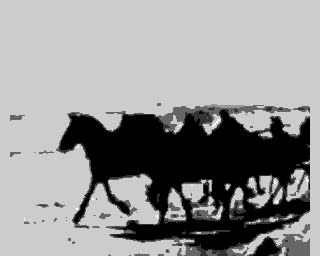 .
.
Fig 3 - Wagon wheels
You will notice that the wheels of the covered wagons appear to be either turning backwards or even oscillating between forward and backwards movement depending on the speed that the wagon is moving. (This will be better illustrated in the lecture than in Fig. 3!) The wagon wheel illusion occurs because the frequency at the wheels was turning when it was photographed interferes with the speed at which the film is being shuttered through the projector. In other words the illusion is an artifact of the strobing cinematic image. This illusion actually occurs with all types of wheels in films, but it is particularly noticeable with wagon wheels, because the length and thickness of their spokes, which emphasise the illusion. But the odd thing is that some people report that you can see the wagon wheel illusion in real life, for instance if you sit in the passenger seat of a moving car and look at the wheels of another moving vehicle. Recent studies have confirmed this as a genuine phenomenon - for example see, Kline et al. (2003), Van Rullen & Koch (2004), Purves, Paydarfar and Andrews (1996). This has interesting implications for theorising about the way we detect actual motion in the brain, for it suggests that the brain might perceive motion as a series of discreet frames, much like the frames of motion pictures, although it is not as yet know for certain how this works.
Persistence of vision
Explaining the mechanics of how motion pictures work is one thing, but it does not explain why still pictures appear to move. In the history of academic writing on film, by far the largest majority of theorists have chosen to explain apparent movement as what is known as 'persistence of vision'. The persistence of vision theory is built on a single hypothesis: when a consecutive sequence of still images is flashed before the eye, each image is merged into a seamless moving continuum, because the brain, or the retina of the eye (proponents of the theory are divided as to which) retains an momentary afterimage of the preceding image, which is then blended with the next image of the sequence. Here is how the Complete Film Dictionary explains the theory:
Motion pictures are actually a series of still photography that record the successive positions of a subject in movement, Because the eye holds the image of one position after that image disappears from the screen and until the next appears and because a shutter in the camera blocks out the intermittent movement from one frame to another the successive images seem to blend into one another creating a continuity of movement. (Koningsberg 1997, 291)
All well and good, but the persistence of vision theory is actually wrong. For example, Nichols & Lederman (1980) write:
The theory that developed to explain the phenomenon of apparent motion has been called the 'persistence of vision,' but perceptual psychologists put forward a different theory, claiming that virtually every other account to explain the phenomenon is wrong and that 'persistence of vision' is nothing more than a myth. (Nichols & Lederman 1980, p96)
Why mention it then? Well, because as students of film and the media you will find many references to it in some, otherwise, quite authoritative text books. For example, André Bazin marveled at how it took so long for the motion picture to come into being "since all the prerequisites had been assembled and the persistence of the image on the retina had been known for a long time" (1967).Christian Metz wrote that "motion in the cinema is not a re-presentation, but a presentation, not the re-experience but the experience of motion" (Metz 7-9). And ironically David Cook, who castigating us for our cinematic illiteracy in the introduction, goes on to cite persistence of vision as the reason why pictures appear to move. So much for cinematic literacy then! As Nichols and Ledermen remark:
The very persistence with which this 'explanation' has been recited says more about the hermetic and impressionistic world of some film scholarship than it does about the actual mechanisms involved. (Nichols & Lederman, op. cit.)
The fact that persistence of vision is wrong can be easily proved with a simple demonstration. I you look at figure 4, you will notice that a series of white dots appear to blink on and off in sequence against a blue background. You should also notice that a "phantom" dot, the same colour as the background, appears to chase around the circle in an anti clockwise direction.
 .
.
Fig 4 white dot, blue background
The phantom dot always takes on the colour the background. So just to prove this, Fig. 5 shows a phantom white dot chasing around a blue circle:
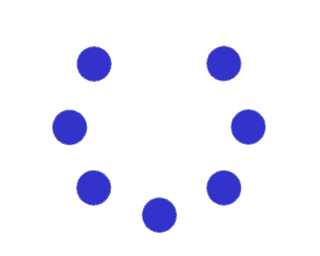 .
.
Fig 5 - blue dot, white background
Now if the persistence of vision is correct it would follow that the apparent movement of this image would be due to the after image of the white dot (Fig. 4) or blue dot (Fig. 5). After-image is actually a very real phenomenon. For example, if you state at the pink triangle of (Fig. 6) for a while and then stare at the grey space next to it and you should see the after-image of the triangle - it will turn green, as the after image appears as complimentary colour of the source image.
 |
 |
Fig 6 - Instructions: stare at the triangle for about 10 seconds, then stare at the grey square.
Now look at this series of pink dots in a white circle of fig 7.
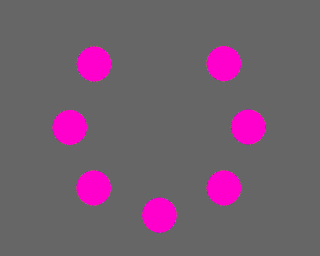 .
.
Fig 7 - pink dot, grey background
The chaser dot is not pink but as in (fig. 4) it takes on the colour of the background. It is possible you see an after image of the pink dot in this example, but you find that it actually fights with the movement of the chaser dot. Thus the very hypothesis on which the persistence of vision rests, does not in fact actually account for the movement of this phantom dot - if anything the after image tends to gets in the way of the perception of movement and you have to try to ignore it.
Phi Phenomena
The reason the dot appears to move is because of a set of two illusions that come under the heading of phi phenomena. Phi phenomena were discovered in 1912 by Max Wertheimer, a pioneer of gestalt theory(Wikipedia, www) - see session 7 for more on gestalt theory. Wertheimer was experimenting with two lamps, turning them off and on in quick succession and noticed that the light appeared to 'jump' from one lamp to the other. 'Phi phenomena' is actually an umbrella term that describes two types of apparent movement. One of these is the one we have already seen in figures 4, 5 & 7; that is the phantom dot chasing around the circle. Confusingly this is called phi-phenomenon, the singular of a phi phenomena. The other type of movement that comes under the heading of phi phenomena (plural) goes by the name of beta movement. Beta movement is illustrated in fig. 8, which is exactly the same image as fig. 4, but with its motion slowed down. However, you will notice that instead of the while dots appearing to be stationary and blinking on and off, that now the dots themselves appear to move - jumping to fill the place place vacated by the previous dot. Also you will also notice that the phantom chaser dot appears to have almost disappeared. .
.
Fig 8 - beta movement
The politics of movement
In its entry on phi phenomena the Complete Film Dictionary is quite condescending. It says:Like persistence of vision this phenomen[a] has been used to explain the illusion of movement created by motion pictures; but whereas the former is largely a physiological result of the optic nerves; the latter is a psychological result of the brains operations. See persistence of vision... (op. cit., 293)
It seems rather odd to describe phi phenomena as being 'psychological', because they are as much physiological as psychological--strictly speaking neuro-physiological (see Wertheim 1994 & Haber & Hershenson 1980). A good question to ask is: if phi phenomena are a better explanation of apparent motion, why do so many sources still attribute it to the persistence of vision? In attempting to answer that question it may be wise to think about those theoretical assumptions which are served by a theory that stresses that apparent movement is due to the eye (persistence of vision) as opposed to those served by a theory that stresses the brain's involvement (phi phenomena). Joseph Anderson and Barbara Fisher (1993) argue that the phi phenomenon privileges a more constructivist approach to the cinema (David Bordwell, Noel Carroll, Kirsten Thompson), whereas the persistence of vision privileges a realist approach (Andre Bazin, Christian Metz, Jean-Louis Baudry).
One could perhaps claim that perpetuating the myth of the persistence of vision made it unnecessary to question the psychological and physiological systems that the spectator brings to the perception of the moving images they see on the screen. Film scholarship founded on an aesthetic tradition (Dyer 1998, 4), which is arguably ill equipped and unprepared to deal with the empiricism inherent in the development of a neuro-physiological theory. In recent years, however, it has become increasingly apparent that while films themselves may be viewed as aesthetic texts, they are texts nevertheless perceived by human beings and interpreted in a social context. Perhaps then the answer to the question, "why does the persistence of vision theory itself persist?", can tell us more about the politics of academic film criticism that it can about the lack of empirical rigour among film theorists.
References and Suggested Reading
Image Credits

|